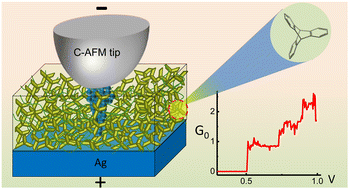Quantized conductance behaviour observed in an atomic switch using triptycene-based polymers†
Abstract
A novel triptycene-based azo polymer (TBAP) was explored as a switching material in an atomic switch showing resistive change under voltage sweep and pulse. Current atomic force microscopy (C-AFM) measurements on a TBAP film on a Ag electrode revealed that a TBAP atomic switch shows volatile and nonvolatile switching, depending on the amplitude of the bias voltage and sweep cycles, in which low-resistance states are attributed to quantized conductance with integer multiples of a single atomic point contact in a Ag filament formed between a C-AFM tip and the Ag electrode. The switch also exhibited a longer retention time with increased conductance states. Switching time from high-resistance to low-resistance states was found to decrease exponentially with an increase in the amplitude of voltage pulses, implying that the nucleation of metal atoms is likely to be the rate-limiting process. Repeated voltage sweeping with varying interval times resulted in a transition from volatile to nonvolatile switching behaviours, mimicking the learning process of the human brain. These results indicate that the TBAP atomic switch has great potential for organic neuromorphic electronics.



 Please wait while we load your content...
Please wait while we load your content...